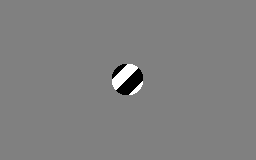Aperture problem
As aperture problem , in the image processing , the problem sometimes referred to, the two-dimensional direction of movement of an object in parallel to the image plane to determine if the color or brightness in the viewed section of the object gradients are parallel. This means that the visible edges are parallel and points of the same color or brightness form parallel lines.
If such an image section is viewed, only the direction of movement perpendicular to the edges or lines of the same color can be recognized. Movement in the direction of an edge does not change the image section and cannot be determined. Different movements of an object can lead to the same image changes. If the edges in an image are only parallel in small areas, enlarging the section can mean that the direction of movement can be fully determined.
